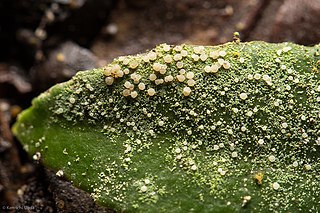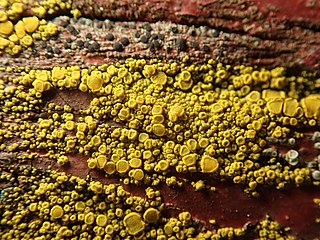
The Lecanoraceae are a family of lichenized fungi in the order Lecanorales. Species of this family have a widespread distribution.

The Physciaceae are a family of mostly lichen-forming fungi belonging to the class Lecanoromycetes in the division Ascomycota. A 2016 estimate placed 19 genera and 601 species in the family.
Rimularia is a genus of lichenized fungi in the family Trapeliaceae. Rimularia was circumscribed by Finnish botanist William Nylander in 1868.

Acanthothecis is a genus of lichen-forming fungi in the family Graphidaceae. The genus was circumscribed by Frederick Edward Clements in 1909.

Lecania is a genus of lichenized fungi in the family Ramalinaceae. The genus was circumscribed by Abramo Bartolommeo Massalongo in 1853. Lecania is widely distributed, especially in temperate regions, and contains about 64 species.

Fellhanera is a genus of mostly leaf-dwelling lichens in the family Pilocarpaceae. The genus, circumscribed by lichenologist Antonín Vězda in 1986, honours Austrian lichenologist Josef Hafellner.

Amandinea is a genus of lichenized fungi in the family Caliciaceae. Genetic studies indicates that the genus Amandinea and Buellia are the same, although this is not widely accepted.

Unguiculariopsis is a genus of lichenicolous fungi in the family Cordieritidaceae. It has 29 species.
Agonimia is a genus of lichen-forming fungi in the family Verrucariaceae.

Psoroglaena is a genus of lichen-forming fungi in the family Verrucariaceae.
Endococcus is a genus of fungi in the class Verrucariaceae. It has 44 species. The genus was circumscribed by the Finnish botanist William Nylander in 1855.

Lecidella is a genus of crustose lichens in the family Lecanoraceae.

Candelariella is a genus of bright yellow, ocher, or greenish yellow crustose or squamulose lichens in the family Candelariaceae. Members of the genus are commonly called eggyolk lichens, goldspeck lichens, or yolk lichens. The genus was circumscribed in 1894 by Swiss lichenologist Johannes Müller Argoviensis, with Candelariella vitellina assigned as the type species.

Gyalidea is a genus of crustose lichens in the family Gomphillaceae. It has 50 species.

Absconditella is a genus of lichenised fungi in the family Stictidaceae. The genus was circumscribed in 1965 by Czech lichenologist Antonín Vězda, with Absconditella sphagnorum assigned as the type species. Absconditella is characterised by gyalectoid apothecia with a hymenium that is not amyloid, without a dark pigment and thalli containing green algae as photobionts. The genus name means "hidden", a reference to the scant structure of the thallus and its small apothecia.

Fuscidea is a genus of crustose lichens in the family Fuscideaceae. It has about 40 species. The genus was circumscribed in 1972 by lichenologists Volkmar Wirth and Antonín Vězda, with Fuscidea aggregatilis assigned as the type species.
Vezdaea is a genus of crustose lichens in the monotypic family Vezdaeaceae, which itself is the only taxon in the order Vezdaeales. The genus was circumscribed by Elisabeth Tschermak-Woess and Josef Poelt in 1976. The genus name honours Czech lichenologist Antonín Vězda.

Phyllobaeis is a genus of lichen-forming fungi in the family Baeomycetaceae. It has six species. The genus was circumscribed by lichenologists Klaus Kalb and Claudia Gierl in 1993, with Phyllobaeis imbricata assigned as the type species. Phyllobaeis differs from Baeomyces by the production of the secondary chemical norstictic acid, as well as the tropical distribution of its species. Most species have a squamulose thallus, but the most recent addition to the genus–the Chinese species P. crustacea–has a crustose thallus.
Bryostigma is a genus of lichen-forming fungi of uncertain familial placement in the order Arthoniales. The genus was circumscribed in 1979 by Josef Poelt and Peter Döbbeler, with the muscicolous lichen Bryostigma leucodontis assigned as the type species. A dozen Arthonia species were transferred into the genus in 2020 following molecular phylogenetic analysis of the family Arthoniaceae that showed distinct phylogenetic lineages that were basal to that family. The genus contains several parasitic species that occur on hosts having chlorococcoid photobionts.














